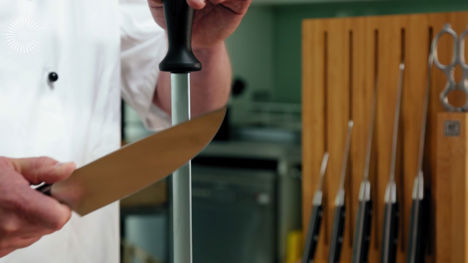Sharpening a knife is often seen as a difficult task to do at home, but if you master the basic techniques it becomes a simple and rewarding task. The more often you use a knife the quicker it will become dull, so it is important to maintain your blade not only to get maximum life from it, but because a sharp knife is also safer to use and increases efficiency in the kitchen.
There are a number of different tools available with which to sharpen and maintain a knife; whetstones, sharpening diamond steels, honing steels, ceramic steels, pull-through sharpeners and sharpening wheels.
The whetstone is generally considered the most precise method of sharpening but it is also the most advanced method. Here we are going to concentrate on honing, diamond steels and using a pull-through sharpener.
Honing and diamond steels
It is important to get into a regular pattern for sharpening your knife. Use a honing steel weekly for maintenance of the edge and a diamond steel monthly for sharpening the blade.
The important thing to remember is that you cannot resharpen an edge that has gone dull with a honing steel. Honing steels are used to maintain the sharpness of an already sharp edge, while if an edge has gone dull, you will need to use a diamond steel to bring back the sharpness.
Place a cloth over a chopping board for the base – the cloth helps prevent the steel from slipping on the flat surface and maintains a steady position.
Hold the steel by the handle with the tip facing downwards, placing the tip on to the cloth.
Holding the knife firmly, position the heel of the blade at a 20° angle to the steel. To help find this angle, place the heel of the blade against the guard (or bolster).
Draw the knife downwards in an arc, heel to tip, finishing with the tip of the knife at the tip of the steel.
Return to the top of the steel but positioning the other side of the blade against the other side of the steel.
Repeat the downwards arc motion on alternate sides of the steel several times to sharpen the blade.
When finished, carefully wipe the blade with a cloth to remove any residue.
Repeat the same movement as above with the honing steel after sharpening to maintain the edge of the blade, holding the steel firmly and finding the correct 20° angle for the blade before sweeping the blade down in an arc.
Pull-through sharpener
A pull-through sharpener has modules for both sharpening and maintaining knives. It is easy to use as the angle for the blade is set by the module, holding the knife in place.
Hold the sharpener firmly with your free hand.
Place the heel of the knife in the tungsten or sharpening module.
Draw the blade through from heel to tip – be careful not to use too much pressure or to push down on the knife; it should only require the weight of your hand to pull through.
Repeat the process a few times.
Next, place the heel of the knife in the ceramic or honing module.
Draw the blade through several times as above to finish then wipe the blade with a cloth.
Testing the blade
Test the sharpness of the knife on a vegetable such as a tomato – the edge of the blade should grip immediately and not slip on the skin or dent the flesh. The blade should then glide through the flesh with the forward motion of the knife, not needing any pressure to cut through.
Get in touch
Please sign in or register to send a comment to Great British Chefs.



